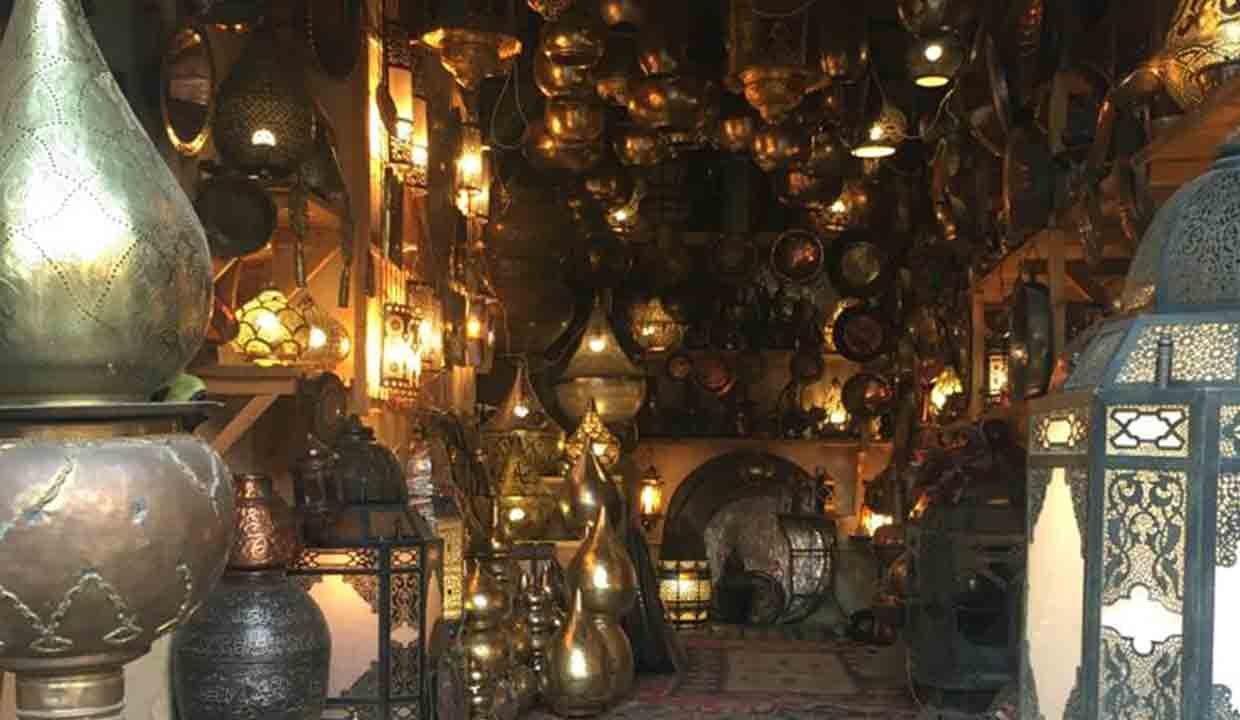Amazing Suq Khan El Khalili , 5 Facts of Khan El Khalili.
Khan El Khalili beckons with its myriad charms: a blend of vibrant commerce, timeless tradition, and living history.
In the 14th century, Sultan Barquq’s (his mosque is one of Egypt’s ten most beautiful mosques) Master of Stables, Jaharkas El Khalili, constructed a large caravanserai (khan) where Khan El Khalili now stands; it was essentially a building that housed merchants and their various goods. Later, other sultans established their own khans/wekalas (another term for caravanserai), and by the late 15th century, the entire region had become a hub for both domestic and foreign trade.
Khan El Khalili is now an integral part of Old Cairo, and the architecture and surrounding areas, such as Moez Street, are reason enough to visit (a UN study discovered that Moez Street has the highest concentration of medieval Islamic architectural treasures in the world). This area called Historic Cairo, is one of Egypt’s seven UNESCO World Heritage Sites.
Nestled in the heart of historic Cairo, the Khan El Khalili Bazaar isn’t merely a marketplace—it’s a sprawling, sensory experience, where the tales of centuries intertwine with the fervor of modern-day commerce. As one steps into its alleys, the air is dense with the aroma of spices, the clinking of copper, and the distant murmur of merchants’ haggling, painting a picture of timeless Egypt.
Khan el-Khalili is one of Cairo’s main attractions. This is the souk of the old city, a large market as crowded as it is noisy, but with spicy and unique colors and scents.
We will cross its labyrinthine streets, real open-air museums. The best place in town to buy souvenirs and copies of Ancient Egyptian artifacts.
A Storied Past
The bazaar’s history can be traced back to the 14th century when Emir Djaharks el-Khalili built a large caravanserai (a kind of inn with a central courtyard) in Cairo. This establishment became the foundation of the modern-day bazaar, eventually growing and evolving into the commercial hub it is today. It thrived during the Mamluk era, as merchants from all corners of the Middle East came to trade their wares.
This is a great place to shop for souvenirs because most vendors speak some English and you can practice your haggling skills and a few Arabic words (for tips, see our General Information on Traveling to Egypt)! Even if you don’t want to buy anything, the market is a fantastic place to wander around and experience the craziness of daily life in Cairo.
A Treasure Trove of Goods
From intricately woven carpets and shimmering lanterns to handcrafted jewelry and aromatic spices, Khan El Khalili is a celebration of Egyptian craftsmanship. Every shop is a trove of treasures waiting to be discovered. The jewelry stores, with their assortment of gold and silver accessories, reflect Egypt’s long-standing tradition of metalwork. Meanwhile, the spice stalls offer an array of fragrant herbs and spices, reminiscent of the ancient trade routes that once passed through Egypt.
Beyond Commerce: A Cultural Experience
The bazaar isn’t just about buying and selling. It’s a living exhibit of Cairo’s deep-rooted traditions. As you wander through its labyrinthine pathways, you might stumble upon an artisan delicately crafting a piece of inlaid wood or a coppersmith shaping a traditional pot. The local coffeehouses, or ‘ahwas’, are cultural hubs where locals engage in animated conversations, play backgammon, and sip on traditional mint tea or strong Turkish coffee.
Notable Landmarks
Within and around Khan El Khalili, one can find several historical landmarks. The Al-Hussein Mosque, one of Cairo’s oldest and most revered, stands nearby. There’s also the Beyn al-Qasreen, a Mamluk-era architectural complex showcasing the splendor of medieval Islamic architecture.
Navigating the Bazaar
The vastness of Khan El Khalili can be overwhelming for first-time visitors. It’s easy to lose oneself in its maze-like alleys. However, this is also part of its charm. Each turn can reveal a new surprise—a quaint cafe, a hidden courtyard, or a shop with unique antiques.
Shopping
While the souk is no longer strictly divided into trading areas, the districts for gold merchants, coppersmiths, and spice vendors are clearly distinct. The rest of the bazaar is filled with stalls selling colorful lanterns, candles, jewelry, perfumes, musical instruments, and other handicrafts – you can pretty much find anything you could want within its walls!
Eating and Drinking
After exhausting yourself exploring the shops and stalls, you won’t have to travel far for a well-deserved rest. The souk also has a number of restaurants, street food vendors, and small, traditional coffeehouses known as maqha in Arabic. Locals and tourists alike frequent this establishment, where you can sit down and enjoy an Arabic coffee, often brewed with spices such as cardamom, or a karkade, a sweet hibiscus tea, while smoking shisha with a hookah.
In Conclusion
Khan El Khalili isn’t just a market; it’s a journey through time. As the sun sets and the lanterns begin to glow, casting intricate patterns of light and shadow, one realizes that this bazaar is not just about commerce; it’s a testament to Cairo’s enduring spirit. From traders and tourists to locals sharing stories over a cup of coffee, Khan El Khalili encapsulates the essence of Cairo—vibrant, historic, and forever alive with tales.


Comment (0)